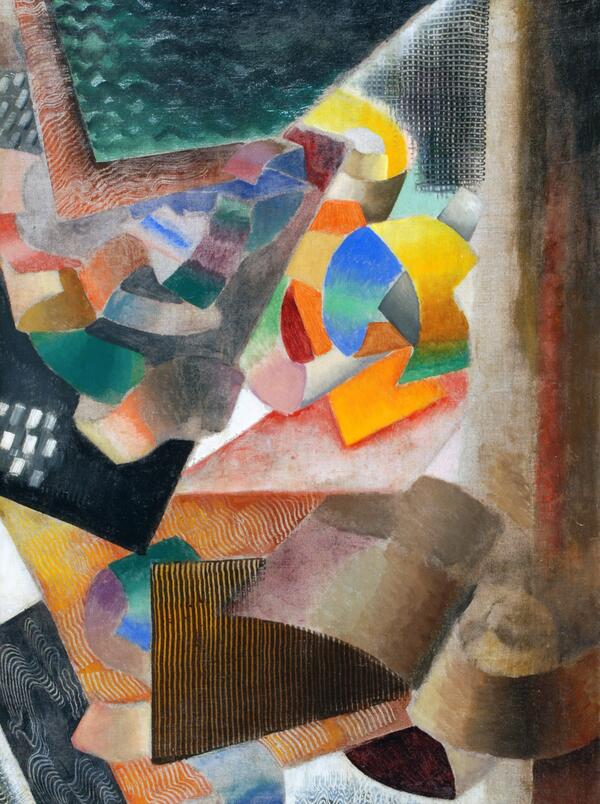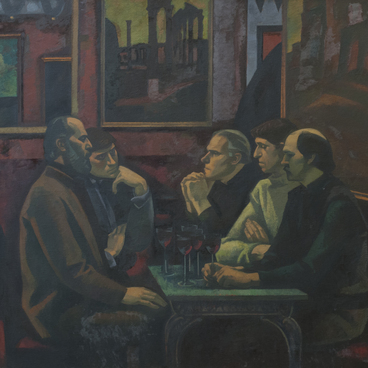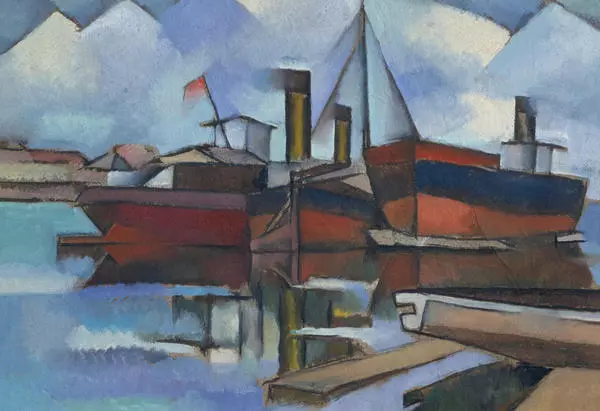Abstract belongs to a group of abstract compositions created in 1918-1919 by the Russian artist Vladimir Baranov, who worked abroad under the pseudonym Daniel Rossinet. The pseudonym, which later became incorporated into the artist’s last name, points to his Russian origin, and was consonant with the last name of the
famous French avant-garde artist Robert Delaunay, with whom Baranov-Rossinet was very friendly.
Together with his friend and teacher, Baranov-Rossinet studied the works of the French scientist Chevreul, which then formed the cornerstone of Orphism, both in theory and practice. Artists who adhered to Orphism tried to express the dynamic movement and musicality of rhythms using the “patterns” in how the main colors along the spectrum converge with each other, and how curvilinear surfaces intersect with each other. Orphism became the main thrust for the style present in the work done by Baranov-Rossinet.
In 1916, when the artist lived in the Scandinavian capital of Christiania (it was given back its ancient name, Oslo, in 1925) and continued to study Chevreul’s theories and color spectrums, he ‘for the first time in his creative work…uses elements of the so-called Mobius strip. At that time, the discovery of the German mathematician August Möbius enjoyed popularity - a visual paradox in which a ribbon turned 180 ° axially, and connected in the form of a ring, has only one surface (the so-called one-sided surface) - and it started to permeate into paintings. For abstract art, the Mobius strip was a very important link across the entire system - this logic game became a kind of key that unlocked the fantasy world of abstract images. Fernand Léger was one of the first to interpret that. And Baranov-Rossinet brought that idea up to perfection, creating a number of brilliant abstract compositions in 1918-1919.’
And those compositions include Abstract. Unlike earlier artistic experiments with the Möbius strip, where figurative elements were still visible, this work represents an absolute, pure world of abstraction. The artist uses the Mobius strip as a new artistic motif that allows him to demonstrate the principles in the idea of unifying color-movement-light-Simultanism, which was formulated by Delaunay and became the conceptual core of Orphism. Baranov-Rossinet, in his artistic compositions, shows how a certain abstract space becomes a living, visible new reality, filled with the movement of color and light.
The work Abstract by Baranov-Rossinet participated in the ‘First Russian Art Exhibition’, held in 1922 in Berlin at the Van Diemen Gallery. This exposition presented all the styles and trends of contemporary Russian art: from the Union of Russian Artists and the Association of Traveling Exhibitions to the World of Art, Jack of Diamonds, and supporters of abstract art. This was one of the first propaganda campaigns on the part of the Soviet authorities, who understood that art is outstandingly convenient to use for political purposes. With its diversity, the exhibition was supposed to show that in the new, flourishing Russia all ‘forms of art’ peacefully coexist, and freedom of creativity reigns.
In 1916, when the artist lived in the Scandinavian capital of Christiania (it was given back its ancient name, Oslo, in 1925) and continued to study Chevreul’s theories and color spectrums, he ‘for the first time in his creative work…uses elements of the so-called Mobius strip. At that time, the discovery of the German mathematician August Möbius enjoyed popularity - a visual paradox in which a ribbon turned 180 ° axially, and connected in the form of a ring, has only one surface (the so-called one-sided surface) - and it started to permeate into paintings. For abstract art, the Mobius strip was a very important link across the entire system - this logic game became a kind of key that unlocked the fantasy world of abstract images. Fernand Léger was one of the first to interpret that. And Baranov-Rossinet brought that idea up to perfection, creating a number of brilliant abstract compositions in 1918-1919.’
And those compositions include Abstract. Unlike earlier artistic experiments with the Möbius strip, where figurative elements were still visible, this work represents an absolute, pure world of abstraction. The artist uses the Mobius strip as a new artistic motif that allows him to demonstrate the principles in the idea of unifying color-movement-light-Simultanism, which was formulated by Delaunay and became the conceptual core of Orphism. Baranov-Rossinet, in his artistic compositions, shows how a certain abstract space becomes a living, visible new reality, filled with the movement of color and light.
The work Abstract by Baranov-Rossinet participated in the ‘First Russian Art Exhibition’, held in 1922 in Berlin at the Van Diemen Gallery. This exposition presented all the styles and trends of contemporary Russian art: from the Union of Russian Artists and the Association of Traveling Exhibitions to the World of Art, Jack of Diamonds, and supporters of abstract art. This was one of the first propaganda campaigns on the part of the Soviet authorities, who understood that art is outstandingly convenient to use for political purposes. With its diversity, the exhibition was supposed to show that in the new, flourishing Russia all ‘forms of art’ peacefully coexist, and freedom of creativity reigns.




